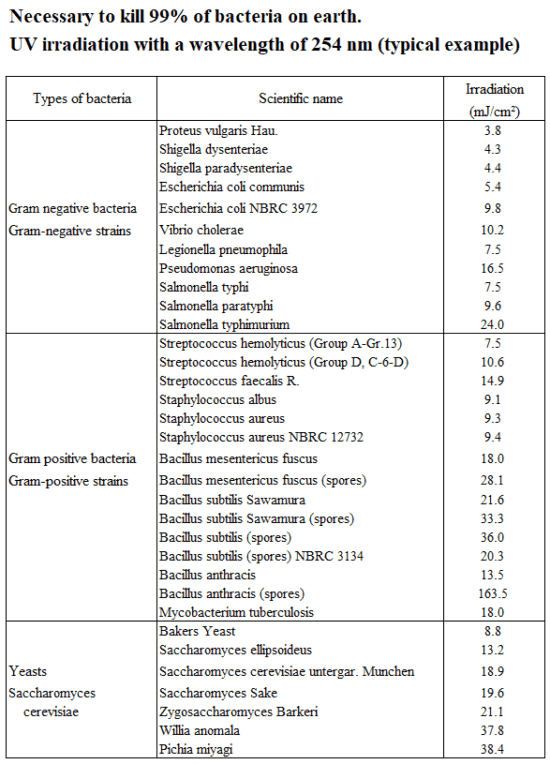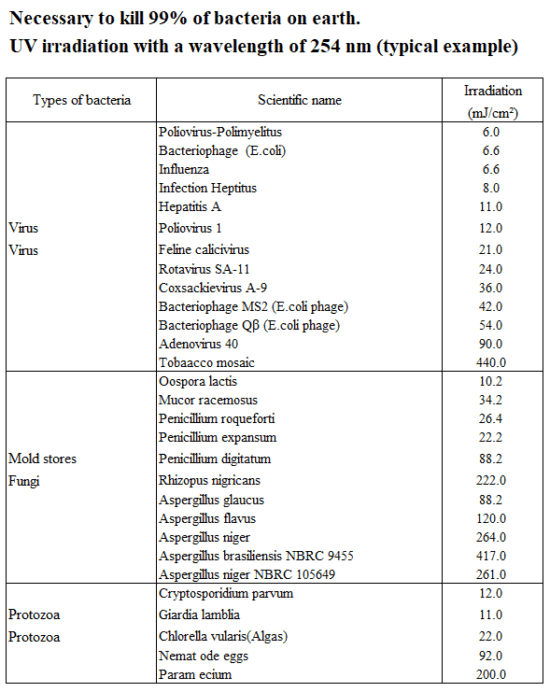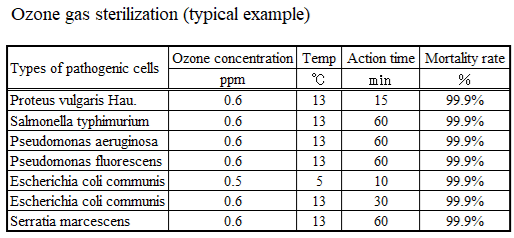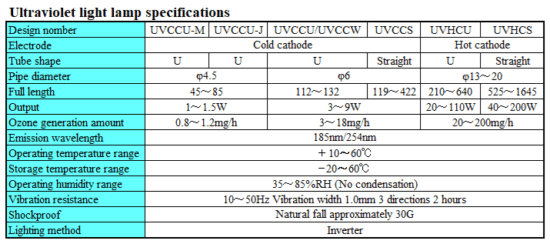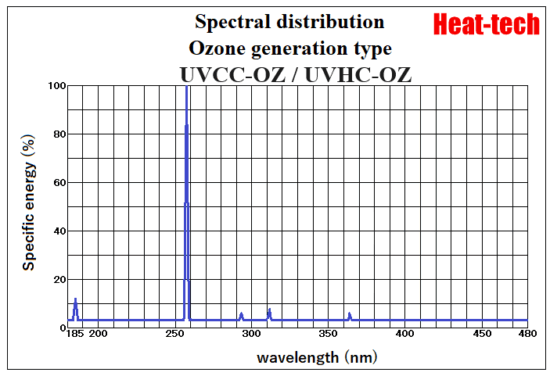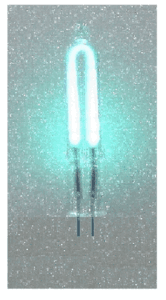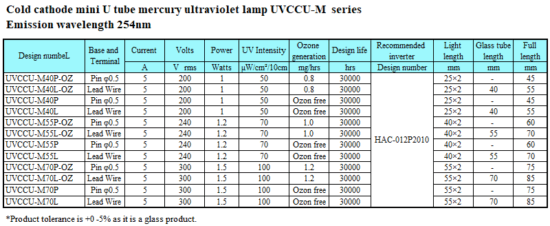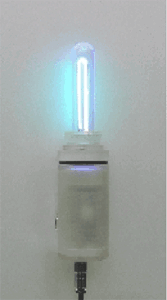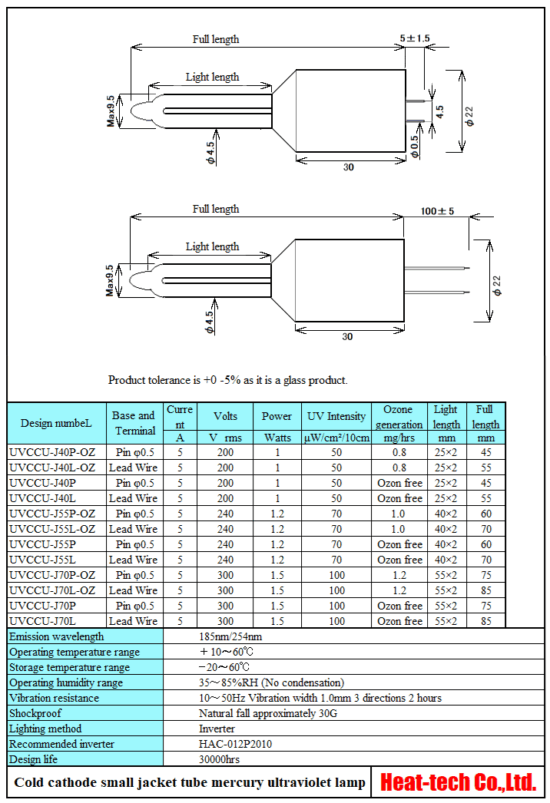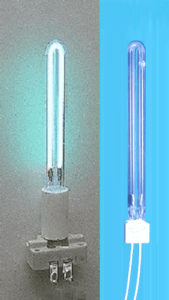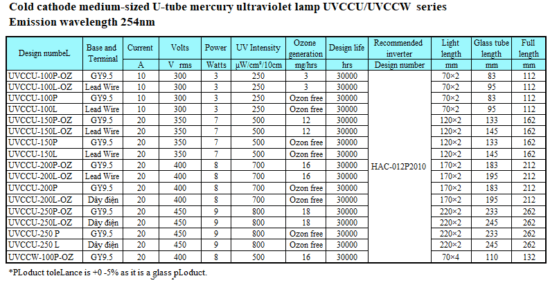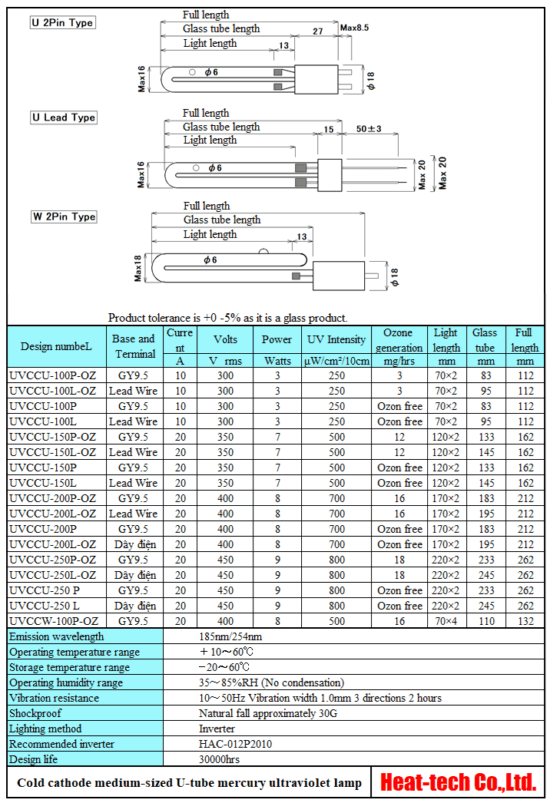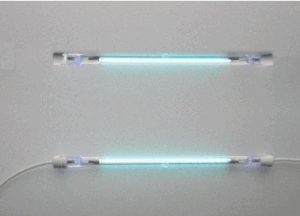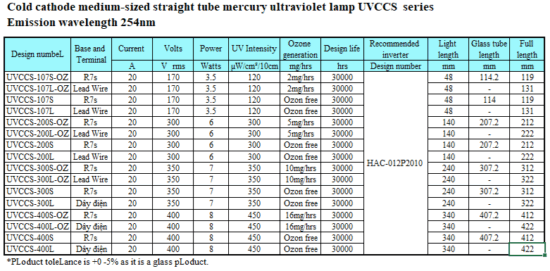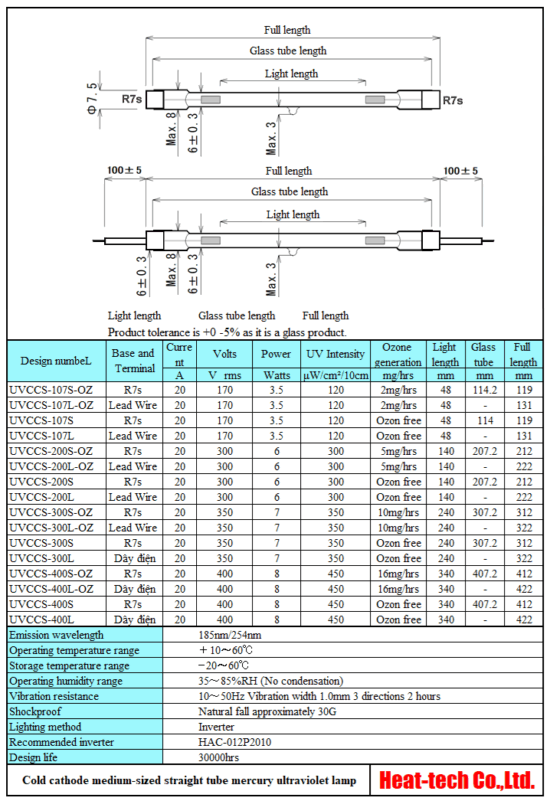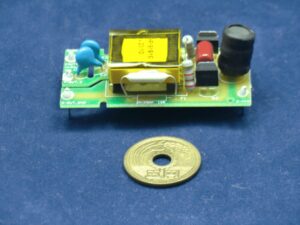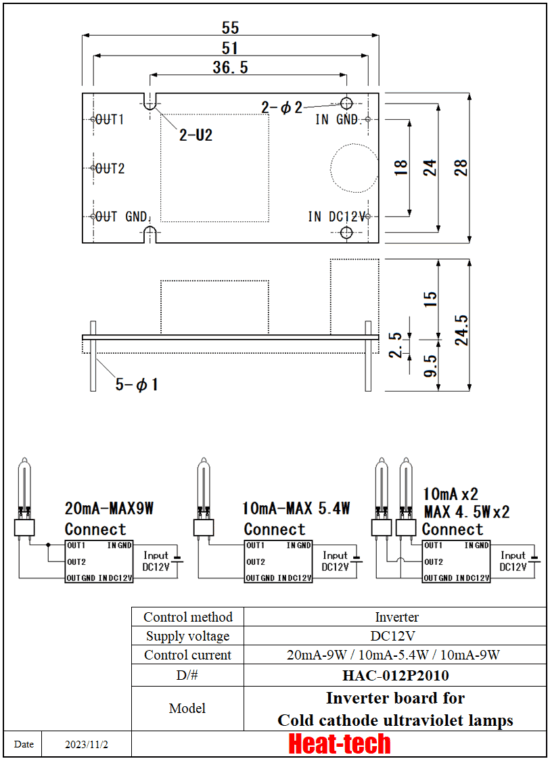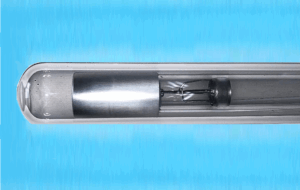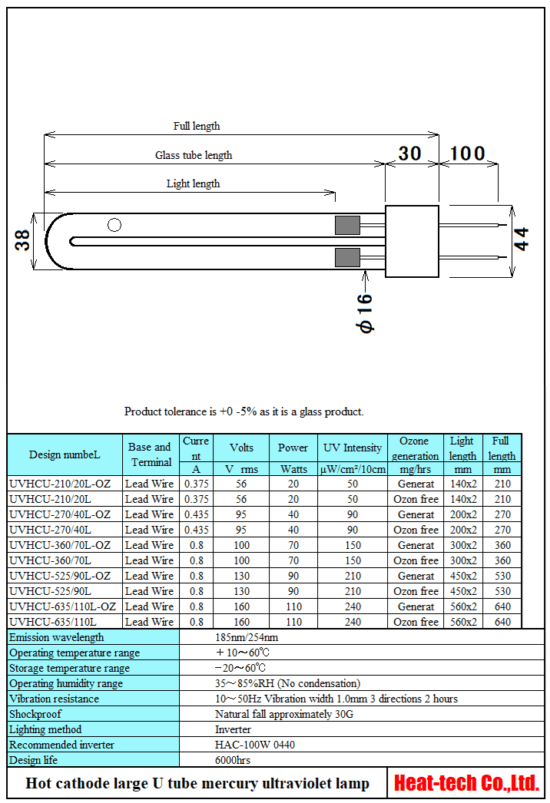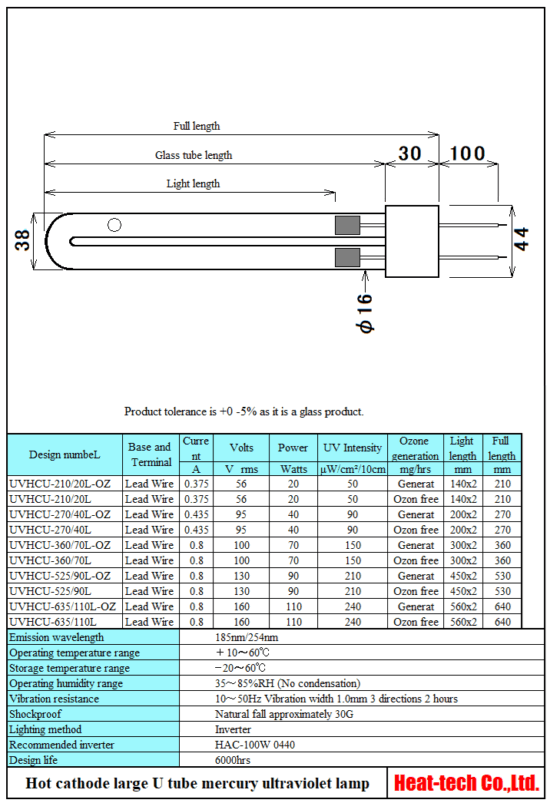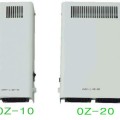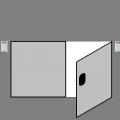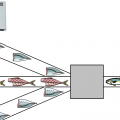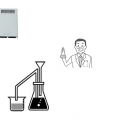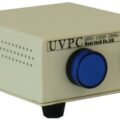INDEX
- << Merit of the ultraviolet rays sterilization >>
- <<Specifications and outline drawings>>
- Spectral distribution
- Cold cathode mini U tube ultraviolet lamp UVCCU-M series
- Cold cathode small jacket tube ultraviolet lamp UVCCU-J series
- Cold cathode medium-sized U tube ultraviolet lamp UVCCU/UVCCW series
- Cold cathode medium-sized straight tube ultraviolet lamp UVCCS series
- Inverter board for cold cathode ultraviolet lamp HAC-012P2010
- Hot cathode large U tube ultraviolet lamp UVHCU series
- Hot cathode large straight tube ultraviolet lamp UVHCS series
Compact facilities, the maintenance cost is cheap
Simpl , time shortening, lowcost
Effective for every species of bacteria
Durability bacteria less
Sterilize it at normal temperature
Do not let an agenda change in quality

<< Merit of the ultraviolet rays sterilization >>
Sunburns change by ultraviolet rays and the action were known for a long time, but it did not advance to the application to the public for only approximately 20 years that the mechanism was elucidated because in front of and the history were shallow though an effect was very high.
However, wide demand is anticipated from the industry to home while the use in various fields is expected now from the plane of the safety and the economy, and the things that the identification of infection courses such as swine flu virus, the O157 is difficult increase.
Sterilizing property
A sterilizing effect is high in the ultraviolet rays, and I reach 1,600 times of wavelength 350nm of the direct rays of the sun, and the wavelength 260nm neighborhood can sterilize all microbes from “a virus” to “mold” in a short time in particular.
Safety
There is not remaining of the poison after the sterilization, and the ultraviolet rays to use do not almost penetrate it other than polyethylene because transmission power is very weak. I peep out by the direct naked eye in a short time, and please do not iiradiate skin directly.
The sterilization effect of ultraviolet rays
1.As for the disinfection to the microbe by ultraviolet rays, ultraviolet rays of complementary wavelength 253.7nm
are absorbed by the nucleic acid of the living bodies, and what lose a restoration function by a chemical change is caused,
and damaging it becomes an established theory.
2.When It demand a sterilization effect by ultraviolet rays, quantity of ultraviolet irradiation is defined by incidence energy,
and it is expressed in the product (μ W / a sec / c square meter) of (sec) as custom in ultraviolet rays illumination
(a μ W / c square meter) and irradiation time.
3.The judgment of the effect defines that sterilization and the cell of the one of the mold or cell group
forms one macro colony as survival and expresses it at survival rate or sterilization rate. It is as an aim of the
one of the sterilization effect judgments for the microbes which the sensitivity for ultraviolet rays uses unlike,
specific sterilization rate and the list of necessary ultraviolet rays exposure dose by a microbe, and become an object.
Irradiation amount required for sterilization
f direct UV irradiation is not possible, ozone gas can also be used to sterilize.
Type of the water sterilizer
The water sterilization is classified roughly into in-side style and out-side style by an irradiation method.
1.It is a method to irradiate glass penetrating ultraviolet rays or running water in the Teflon resin pipe from the outside,
and out-side style does not have to shut it tightly, and, as for the structure, it is easy, but use efficiency of the ratio
ultraviolet radiation light lowers in in-side style.
2.As for in-side style, a dip does a double tube which wrapped a sterilization lamp in a pipe out of quartz more-type
sterilization lamp during a current, and I am underwater, and a large quantity of water processing is enabled in a high,
compact device in out-side style because it is a method to emit ultraviolet rays.
Poblems of other sterilization methods
Heat sterilization
It let bacteria sterilization agenda change in quality.
An energy cost is high expensive.
By a cooling process, bacteria are easy to stick.
It is not suitable for heat-resistant bacteria.
Sterilization with the medicine
There is residual property.
Second processing is necessary.
It generate resistant bacteria.
Filter sanitization
Exchange frequency is demanded.
Running cost is high expensive.
The principle of cleaning and modification using ultraviolet rays
Ultraviolet reforming
Ultraviolet rays are irradiated to the organic irradiated object, and then cut the chemical bond of the surface layer.
Active oxygen is separated from the generated ozone with ultraviolet light, attached to a molecule of the cut surface layer and convert it to a highly hydrophilic functional group.
Ultraviolet cleaning
By the action of active oxygen separated from ozone generated by the action of ultraviolet radiation, organic pollutants and volatile H2O, CO, CO2, NO2 and removed by decomposing changes made to such.
To overcome the technical difficulties, and ultra-compact, high-output. It now can be applied in many fields.
<<Specifications and outline drawings>>
We manufacture a wide range of products from small cold cathode lamps to large hot cathode lamps.
A quartz glass low-pressure mercury discharge lamp that uses mercury discharge efficiently irradiates 254nm and 185nm ultraviolet rays.
254nm is a wavelength that has a bactericidal effect, and 185nm is a wavelength that has an ozone growth effect.
Ultraviolet lamps contain small amounts of mercury and rare gases such as neon and argon.
Sterilization using ultraviolet light is effective against most types of bacteria, including bacteria, viruses, and mold. Taking advantage of this feature, it can be used in medical, food, electronics, water, air sterilization, etc.
It is used in a wide range of fields. In addition, ultraviolet sterilization is used in a wide range of fields because it is easy to handle, does not cause secondary contamination, and does not require secondary treatment.
Ozone is used in a wide range of applications, including optical cleaning, surface treatment, air sterilization, and deodorization.
Ozone lamps are special ultraviolet lamps that emit ultraviolet light with two wavelengths: 253.7nm and 184.9nm. It is used for purposes such as light cleaning, surface treatment, air sterilization, and deodorization.
We offer a variety of lamps, including lamps with a wavelength of 254nm, which has a strong sterilizing effect, and lamps with a wavelength of 185nm, which has a strong oxidizing and deodorizing effect, so that they can be used depending on the purpose.
Spectral distribution
Cold cathode mini U tube ultraviolet lamp UVCCU-M series
UVCCU-M is a small cold cathode type UV lamp with a tube diameter of 4.5 mm.
It efficiently emits sterilizing wavelength around 254nm and is used for sterilization and deodorization.
It is characterized by low output but long life.
There are ozone generating type (185nm) and ozone free type.
Because they are ultra-compact, they are useful when you want to keep them small and compact, or when you want to place them side by side for surface illumination.
Cold cathode small jacket tube ultraviolet lamp UVCCU-J series
UVCCU-J is a model with a jacket attached to UVCCU-M.
It efficiently emits sterilizing wavelength around 254nm and is used for sterilization and deodorization.
It is characterized by low output but long life.
There are ozone generating type (185nm) and ozone free type.
Since it is attached to a jacket, it is suitable for single use.
Cold cathode medium-sized U tube ultraviolet lamp UVCCU/UVCCW series
UVCCU is a cold cathode type medium-sized ultraviolet lamp with a tube diameter of φ6 mm.
It is characterized by a long lifespan.
It efficiently emits sterilizing wavelength around 254nm and is used for sterilization and deodorization.
It can also be used in UV/O3 precision cleaning processes for semiconductors.
There are ozone generating type (185nm) and ozone free type.
Easy wiring design
Wiring design is easy due to U-tube type wiring on one side.
We can produce lead wire type and socket type.
W tube type
There is also a W-tube type that is even smaller by bending the U-shape.
Ozone characteristics
The 185nm far ultraviolet light (or vacuum ultraviolet light) emitted from a low-pressure mercury lamp efficiently converts oxygen in the air into ozone.
In addition, the generated ozone enables more powerful sterilization and deodorization.
It is used in all kinds of fields, including water sterilization, agriculture, medicine, and food.
Cold cathode medium-sized straight tube ultraviolet lamp UVCCS series
UVCCS is a cold cathode type medium-sized ultraviolet lamp with a tube diameter of φ6 mm.
It is characterized by a long lifespan.
It efficiently emits sterilizing wavelength around 254nm and is used for sterilization and deodorization.
It can also be used in UV/O3 precision cleaning processes for semiconductors.
There are ozone generating type (185nm) and ozone free type.
Straight pipe type
Since they are straight tube types, they can illuminate a large area when used side by side.
We can produce lead wire type and socket type.
Ozone characteristics
The 185nm far ultraviolet light (or vacuum ultraviolet light) emitted from a low-pressure mercury lamp efficiently converts oxygen in the air into ozone.
In addition, the generated ozone enables more powerful sterilization and deodorization.
It is used in all kinds of fields, including water sterilization, agriculture, medicine, and food.
Inverter board for cold cathode ultraviolet lamp HAC-012P2010
This is a printed circuit board for making your own controller.
By applying DC12V, you can light one or two cold cathode ultraviolet lamps.
Hot cathode large U tube ultraviolet lamp UVHCU series
This germicidal lamp uses quartz glass with extremely high ultraviolet transmittance.
Using advanced envelope processing technology, it is possible to prototype ultraviolet lamps of various shapes.
Water resistant double tube type custom made product
A special double tube structure is available for underwater lighting.
The double tube structure has little drop in sterilizing radiation even at low temperatures, allowing for stable sterilization.
The UV lamp is sealed with a quartz tube to prevent the germicidal radiation from dropping due to the temperature drop in the glass tube caused by running water.
Ultraviolet (254nm)
Hot cathode germicidal lamps use ultraviolet light (254nm) to instantly inactivate viruses and bacteria when irradiated. Also, unlike chemical sterilization, it does not create resistant bacteria, so you can use it with confidence.
Ozone characteristics
The disinfecting effect of ozone is more than twice that of chlorine. Also, unlike ultraviolet sterilization, ozone molecules travel into air currents far away, decomposing odor particles, deodorizing, and sterilizing bacteria. This allows for efficient sterilization and deodorization.
decomposes organic matter
Ozone not only has a sterilizing and deodorizing effect, but also has a strong oxidizing effect that decomposes organic matter. It is used for waste oil treatment, oil traps in sewers, and for creating ultrapure water needed when creating semiconductors.
stable output
Normally, cold cathode and hot cathode germicidal lamps reduce their luminous efficiency and the amount of ultraviolet rays attenuated at low temperatures or when convection occurs. However, at Hakuron Seisakusho, we are able to stably irradiate high-output ultraviolet rays even in low-temperature environments using special coils and lighting methods.
Hot cathode large straight tube ultraviolet lamp UVHCS series
This germicidal lamp uses quartz glass with extremely high ultraviolet transmittance.
Using advanced envelope processing technology, it is possible to prototype ultraviolet lamps of various shapes.
Ultraviolet (254nm)
Hot cathode germicidal lamps use ultraviolet light (254nm) to instantly inactivate viruses and bacteria when irradiated. Also, unlike chemical sterilization, it does not create resistant bacteria, so you can use it with confidence.
Ozone characteristics
The disinfecting effect of ozone is more than twice that of chlorine. Also, unlike ultraviolet sterilization, ozone molecules travel into air currents far away, decomposing odor particles, deodorizing, and sterilizing bacteria. This allows for efficient sterilization and deodorization.
decomposes organic matter
Ozone not only has a sterilizing and deodorizing effect, but also has a strong oxidizing effect that decomposes organic matter. It is used for waste oil treatment, oil traps in sewers, and for creating ultrapure water needed when creating semiconductors.
stable output
Normally, cold cathode and hot cathode germicidal lamps reduce their luminous efficiency and reduce the amount of ultraviolet rays at low temperatures or when convection occurs. However, at Hakuron Seisakusho, we are able to stably irradiate high-output ultraviolet rays even in low-temperature environments using special coils and lighting methods.
Water resistant specifications
This straight tube type can be used with a special double tube structure for underwater lighting. The double tube structure has little drop in sterilizing radiation even at low temperatures, allowing for stable sterilization. We can also sell just the quartz glass jacket tube.
Note: Stabilizer is required for lighting.
We offer a wide range of sizes from small lamps to large lamps.
Lamp length
Please let us know your desired size referring to the table below.
Outer diameter
We will respond to a wide range of requests. Please let us know your desired outer diameter.
 HEAT-TECH Best Technology Online Shop
HEAT-TECH Best Technology Online Shop 

